Sunningdale Golf Club - the top inland course in the UK
 Many will argue that Sunningdale Golf Club has been the UK's number one inland golf course venue for many years already, but it became official in October, with the release of the Golf Monthly Top 100 Golf Courses in the UK and Ireland rankings, which sees the 'New' heathland course move up seven places to number ten in the two years since the last 2010 figures were announced. The Old Course, which is historically the most popular of the two, moved up six places to fourteenth, meaning the pair are now the number one and two highest ranked inland courses in the UK.
Many will argue that Sunningdale Golf Club has been the UK's number one inland golf course venue for many years already, but it became official in October, with the release of the Golf Monthly Top 100 Golf Courses in the UK and Ireland rankings, which sees the 'New' heathland course move up seven places to number ten in the two years since the last 2010 figures were announced. The Old Course, which is historically the most popular of the two, moved up six places to fourteenth, meaning the pair are now the number one and two highest ranked inland courses in the UK.
This news not only solidifies the club's standing in the world of golf, but also represents a milestone for Sunningdale's ambitious Course and Estates Manager, whose set objective, when joining the team seven years ago, was not only to improve the appeal of the very challenging New Course, but also to achieve the impressive feat that has, this month, been realised.
 Murray Long is typical of the breed of character found among the Sunningdale staff, from the greens team to the clubhouse staff to the top level management. Organisation, thorough planning and ambition are what typifies Murray's approach to running the vast course and estates geography, which encompasses some 700 acres and includes duties ranging from the greens and forestry management to environmentalism and sustainability. The Club is "virtually never shut", according to Murray, with golf played at any time of year. Even on Christmas Day you'll likely see members enjoying a festive round.
Murray Long is typical of the breed of character found among the Sunningdale staff, from the greens team to the clubhouse staff to the top level management. Organisation, thorough planning and ambition are what typifies Murray's approach to running the vast course and estates geography, which encompasses some 700 acres and includes duties ranging from the greens and forestry management to environmentalism and sustainability. The Club is "virtually never shut", according to Murray, with golf played at any time of year. Even on Christmas Day you'll likely see members enjoying a festive round.
"All course requirements have to be carefully managed and planned around our Members Fixture List to ensure we can offer year round play and deliver competitions," explains Murray.
Sunningdale's Course Policy Document is the staff 'Bible', including a plan for every task for the year, from cut height to cut frequency to spraying frequency and pest control. "It's in place to protect us as a Club and protect what we stand for," says Murray. "We all buy into the policy document, it's a procedural manual and a reference book - and it's a safety mechanism."
 Murray leads the line alongside Deputy Course Manager Jamie Wilson, who's been in the post since 2007, previously spending time in Europe managing the Crete Golf Club; in Scotland he was the Course Manager at Dukes in St Andrew's, and also led the Ryder Cup greens team at the Belfry.
Murray leads the line alongside Deputy Course Manager Jamie Wilson, who's been in the post since 2007, previously spending time in Europe managing the Crete Golf Club; in Scotland he was the Course Manager at Dukes in St Andrew's, and also led the Ryder Cup greens team at the Belfry.
Murray, 42, joined two years earlier in 2005, from Coombe Hill Golf Club in Kingston, Surrey. Prior to that he spent three years at Ellesborough Golf Club, where he gained his level 1 and 2 qualifications. Murray started his greenkeeping life at the ripe old age of 16 - a late starter in this business - working first at Chesham & Leyhill Golf Club. "I was only there for six months, but it proved to be a steep learning curve for me," Murray recalls. "There were only two greens staff, including me, and we did everything. I was thrown in at the deep end."
It was the inspiration of a family member that first gave Murray a taste for the trade. "I remember my grandfather would spend hours going up and down with the cylinder mower, trying to get the stripes just right, poring over the fine detail. It was his influence that gave me the bug and, as soon as I left, I looked for work in the industry." Sadly, his grandfather never got the chance to see him take his first step on the ladder, but if he had "I'm sure I would have spent more time on his lawn," he jokes.
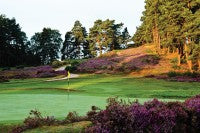 Those days must seem but a distant memory for Murray, who now has, arguably, the more challenging task of maintaining the high benchmark set for the two sought after courses.
Those days must seem but a distant memory for Murray, who now has, arguably, the more challenging task of maintaining the high benchmark set for the two sought after courses.
Sunningdale's Old Course was the work of course designer Willie Park Junior, and officially opened in 1900. It was laid out over a mixture of hills, heath and woodland, a landscape considered suitable for golf course construction. At the time, the course was considered extremely long, and its popularity owed much to the development of the Haskell ball, initially imported from the United States.
The Park design was considered revolutionary at the time and, within a few years, Harry Colt, the then Club Secretary, had modified a selection of holes and drastically altered others, incorporating his trademark style that the Sunningdale Committee is very much looking to bring back today. The original improvements were so impressive that Bernard Darwin wrote in 1910 in the Golf Courses of the British Isles journal that several of the holes had been "greatly improved" by the Colt changes.
 The Old Course has an impressive track record throughout its history, hosting a range of events from News of the World Professional Match Play Championship in 1903, qualifying for the British Open Championship in 1926, won by the legendary Bobby Jones, numerous European Open Championships, many Ladies Open Championships, the Walker Cup, the 2009 Senior Open Championship and the International Final Qualification for the Open since 2004, which is played over both courses. "The Old Course has elevated tees, attractive holes, more generous fairways and some very deceptive holes. It's the full package," Murray believes.
The Old Course has an impressive track record throughout its history, hosting a range of events from News of the World Professional Match Play Championship in 1903, qualifying for the British Open Championship in 1926, won by the legendary Bobby Jones, numerous European Open Championships, many Ladies Open Championships, the Walker Cup, the 2009 Senior Open Championship and the International Final Qualification for the Open since 2004, which is played over both courses. "The Old Course has elevated tees, attractive holes, more generous fairways and some very deceptive holes. It's the full package," Murray believes.
"The New Course is hard from the start, with more of a links feel. It's very open and exposed, which has traditionally meant fewer members tackled it," he adds. "It was one of the main goals I was set when I started here - to raise the profile of the New Course. I'm delighted that this has now been realised."
Sunningdale's New Course was designed by Colt in 1923, built on heathland that included small copses and broom. The first five holes are more or less now as they were, although the track of the first and eighteenth holes had to be reversed. Colt's sixth hole played down the line of today's ninth,  along its left hand ridge, to a green over the path to Valley's End and the Brickmaker's Arms. The tenth hole was played from the hill above, onto today's tenth green, and the last eight holes were much the same as current, although the thirteenth was fifty yards longer, and other green locations have also been altered over the years. More land was acquired in 1934, allowing course architect Tom Simpson to scrap the hilly holes and create a clockwise loop, with a 500 yard tenth onto a green on today's eleventh fairway, and the course renamed the 'Jubilee'.
along its left hand ridge, to a green over the path to Valley's End and the Brickmaker's Arms. The tenth hole was played from the hill above, onto today's tenth green, and the last eight holes were much the same as current, although the thirteenth was fifty yards longer, and other green locations have also been altered over the years. More land was acquired in 1934, allowing course architect Tom Simpson to scrap the hilly holes and create a clockwise loop, with a 500 yard tenth onto a green on today's eleventh fairway, and the course renamed the 'Jubilee'.
The change proved unpopular with members so, in 1939, Colt was asked to reassess his work. He reversed the loop, using Simpson's greens, and built new ones for the thirteenth and eighteenth holes, a redesign still enjoyed today.
Golf course design has evolved since Colt's day, as the scientific nature of the sport progresses apace. But, at Sunningdale, the philosophy of combining new and old, uniting heritage qualities with current practice, has remained a constant. "When the course was first designed, it was all about push up greens, designed to hold water. Today, instead of converting the greens to be 'modern', we are slowly working to make them free draining through good husbandry, not building new," explains Murray.
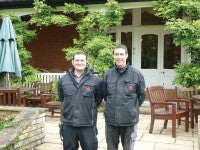
It takes a lot of forward planning to reach the position Sunningdale are in now, one where the management trust staff to make decisions without needing to hold their hand. "Jamie and Grant Stewart - Head Greenkeeper of the New Course, former Head Greenkeeper at the Torrance & Kittocks Courses at Fairmont, St. Andrews - and I work closely to decide on the focus for the two courses," explains Murray. "We review our plan annually, looking at the Members Fixture Lists and tailor the plan around that. It's difficult to fit everything in at the same time, so it's our policy to always work a week ahead, looking at the weather especially.""
The maintenance philosophy is very much based on a 'little and often' approach, topping up all the time, whether that be spraying or topdressing. "If you stay on top, then the risk of being caught short, or your ability to react to unexpected situations, is more effective."
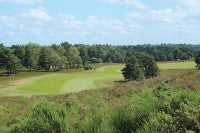 The club has a high number of category one golfers, and some very good amateurs, so preparing consistently high quality turf is paramount. "We target our nutrients," insists Murray, "using small amounts regularly, and not applying any granular feed. Targeted spraying is what we believe in, there's no point lumping on granular and letting it do its thing. You can't control it. We don't like what we can't control."
The club has a high number of category one golfers, and some very good amateurs, so preparing consistently high quality turf is paramount. "We target our nutrients," insists Murray, "using small amounts regularly, and not applying any granular feed. Targeted spraying is what we believe in, there's no point lumping on granular and letting it do its thing. You can't control it. We don't like what we can't control."
The little and often mentality might not be the most cost effective way of doing things, Murray stresses, but it allows him and the team to effect the minute details. "It's certainly a more difficult way of running a golf course, but it means we can tailor the feeding to the weather, granular feed doesn't allow that."
Murray's annual budgetary plan shapes what can be achieved by his team, and it takes on the same multi-faceted dimension that typifies the running of other aspects of the club. Murray, Jamie and Grant work on the budget narrative, starting in late August, putting all their thoughts on a word document, before transferring detail onto spread sheets. This works as a team process, so everyone has an understanding of the programme.
"We keep spread sheets on everything from the last six years, it's important to have quantifiable data to hand," Jamie believes. "With data, we can monitor exactly why we are doing what we do and can compare to previous years, even down to the day. This gives us the ammunition we need to hone and refine our process each year."
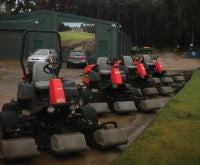 A look outside golf specific practices is another way Murray and the team keep ahead of the game. "The way to innovate is to always look ahead, at new technologies and developments. Football grounds are a good example; we can learn a lot from what they do. An industry can quickly get incestuous if you don't look beyond your own sport, and the pool of knowledge isn't widened as a result."
A look outside golf specific practices is another way Murray and the team keep ahead of the game. "The way to innovate is to always look ahead, at new technologies and developments. Football grounds are a good example; we can learn a lot from what they do. An industry can quickly get incestuous if you don't look beyond your own sport, and the pool of knowledge isn't widened as a result."
Whilst Sunningdale are very open to technological advances, and are clearly benefitting from the industry embracing changes, Murray warns against overkill, insisting that, at its core, the basic greenkeeping practices must be done well. "Our way of doing things may be quite technical in some eyes, it's really all down to good planning and a clear demarcation of duties. Ultimately, the key to our success is simple - lots of topdressing and the right balance of organic matter. This is no different to what greenkeepers have been doing here for years. It's important not to lose sight of core good practice."
Murray is an advocate of lifelong learning, and is keen for his staff to keep him on his toes. "Education can only help the industry, and we encourage our team to flex their muscles outside the UK if possible." Three quarters of the Sunningdale team have gone to America to work on courses as part of the Ohio State University programme. "It's good to step outside your comfort zone, it makes you better at the job and helps team members be proactive rather than just be told what to do," he continues. "We are also in the fortunate position here that we can call on the professionals, like Mark De'ath from Headland Amenity, to come in, take seminars and give talks on scientific developments and practices."
A strong training ethic is not just something close to Murray's heart, but a principle that runs through the core of Sunningdale, one that has been consistently demonstrated through the Investor in People scheme. Over a five year period, the Club has progressed to Silver Status and is now part of the Gold Status audit programme.
 Sunningdale has a greenkeeping team of twenty four in total, include twelve on the Old Course and eight on the New Course, the imbalance not due to any preference, but rather because the Old has double the bunkers, 104 compared to 52 on the New. Bunkering was an integral and signature part of Harry Colt's design, enhancing the aesthetics of the course, whilst positioning them to make play deceptive.
Sunningdale has a greenkeeping team of twenty four in total, include twelve on the Old Course and eight on the New Course, the imbalance not due to any preference, but rather because the Old has double the bunkers, 104 compared to 52 on the New. Bunkering was an integral and signature part of Harry Colt's design, enhancing the aesthetics of the course, whilst positioning them to make play deceptive.
These century old methods are back in vogue amongst Murray and the team, who are looking to bring back these qualities by introducing additional bunkers to add to the quality of play. "The focus for our general winter plan this year is to renovate the bunkers on the Old Course. Our remit is to tweak sympathetically to the Harry Colt style. We want to highlight this part of our heritage. After all, we're all just custodians of the club for future generations."
The Sunningdale maintenance plan has been running for ten years and, aside from bunkering plans, they are set to focus on producing a finer quality turf. "It's all about fine tuning now. We've reached the stage where we have very few problems on the greens. It's the little innovations that can make the difference now, whether that is using growth regulators, the clegghammer or a trueness metre. We're testing a range of new technologies to find out what gives us the best turf."
 "The profile of the greens is very good, so the dramatic increase in the volume of rain has made little difference," says. Murray who, like his counterparts, has had to contend with a slight growth in organic matter as a result. "But, the benefit of having the records means we can demonstrate that organic build up is a natural result of the wetter summer and warmer autumn weather, not due to any failing on our part."
"The profile of the greens is very good, so the dramatic increase in the volume of rain has made little difference," says. Murray who, like his counterparts, has had to contend with a slight growth in organic matter as a result. "But, the benefit of having the records means we can demonstrate that organic build up is a natural result of the wetter summer and warmer autumn weather, not due to any failing on our part."
"Good topdressing practice is the most critical element to addressing this issue, and doing it regularly makes a massive difference. I'd sooner sacrifice fertiliser than topdressing, if the choice had to be made. We apply an average of 300 tonnes of medium coarse straight sand topdressing per course."
The advocacy of such practices is arguably why Sunningdale has consistently firm, dry greens. The issue of organic matter, and how much or how little there is always comes up as a point of concern for many clubs, yet Murray is insistent that, often, too much is made of it.
"Organic matter is a part of life, you'll never entirely get rid and, for a healthy green, you need a little. Organic matter affects the speed of the ball so, if there's too little, then the greens become overly firm and don't hold the ball, which is as irritating for members as one that slows up," he explains. "It's a fine balance, good greens are about trueness, receptiveness and firmness, not speed. A very high percentage of our members are single handicappers, so they know what good greens play like."
Nearly half of Sunningdale's large acreage is taken up by land not used for golf, but it requires the same rigorous prior planning as applied to the running of the two courses.
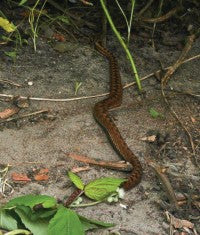 Some 300 acres is registered as a Site of Special Scientific Interest (SSSI). "We work closely with the Amphibian and Reptile Conservation Trust (ARC), who manage the SSSI on our behalf, " explains Murray. Every type of reptile is represented at Sunningdale, alongside some rare bird species, such as nightjars. The quality of maintenance of these scientifically sensitive areas was highlighted in 2011 with the signing of a Higher Level Stewardship (HLS) agreement with Natural England.
Some 300 acres is registered as a Site of Special Scientific Interest (SSSI). "We work closely with the Amphibian and Reptile Conservation Trust (ARC), who manage the SSSI on our behalf, " explains Murray. Every type of reptile is represented at Sunningdale, alongside some rare bird species, such as nightjars. The quality of maintenance of these scientifically sensitive areas was highlighted in 2011 with the signing of a Higher Level Stewardship (HLS) agreement with Natural England.
The Clubs run two separate woodland management programmes, the first as part of the HLS agreement to expand heathland, turning parts of the course back into natural lowland heathland, which will involve removing large numbers of Silver Birch.
The second aspect will be the woodland plan for the Old Course, which involves the thinning out of parts of the dense woodland. High growth density disrupts air flow and light, which affects growth underneath the canopy and discourages indigenous species flourishing. "Pine mulch has built up over 100 years in some cases, and it's reached over a foot deep," Jamie explains. "By getting rid of this, we want to encourage the growth of heather again. The seed can lay dormant for years and spring into life quite quickly once it's given air and light. We aim to recycle the pine mulch and use it for tree regeneration in other areas."
Recycling is an area where Sunningdale have made a big commitment, both for fuel and water management. "The option of wood burners is something we're talking seriously about now," Murray explains. "We can burn the wood from the felled trees and use it to fuel the houses on site. Also, instead of spraying the stumps to stop regrowth, we might let them grow and use them as a sustainable source of fuel for the future. We want to make all our land work, there's nothing about our site that can't be sustainable."
Water management was brought into sharper focus last spring, when an unexpected drought was announced. Although it was followed by an entire summer downpour, it highlighted the necessity of water conservation in the South East. Sunningdale is no different, and are on target to meet their goal of being entirely self sufficient. Armed with a Waste2Water facility, a bore hole and reservoirs, the club rely little on mains water supply.
The latest rankings justify Sunningdale's fearsome efforts to foster the two greatest inland courses in the UK. Murray's mission to develop the courses still further mean the only way is up.
 The Top Twenty courses
The Top Twenty courses
1 Muirfield
2 Royal County Down
3 St Andrews - Old
4 Turnberry Ailsa
5 Royal Birkdale
6 Royal St George's
7 Royal Lytham & St Annes
8 Carnoustie Championship
9 Royal Dornoch - Championship
10 Sunningdale - New
11 Waterville
12 Royal Portrush - Dunluce
13 Ballybunion - Old
14 Sunningdale - Old
15 Royal Liverpool
16 Kingsbarns
17 The European Club
18 Woodhall Spa - Hotchkin
19 Royal Aberdeen - Balgownie
20 Ganton
Visit www.golf-monthly.co.uk/courses to see the full list of the top one hundred UK and Ireland courses.
